Tagged with 'Designers'


-
CSM Jewellery 2013 - The Designers Part I
CSM Jewellery 2013 - The Designers Part I
In addition to the prize-winning work by Bella Mung (pictured above), there were many other surprising, innovative and creative uses of pearls in the CSM jewellery 2013 degree show this year.
Here we feature the first in a two part series of short interviews with designers from the CSM Jewellery 2013 show, including in this article - Beatrice Bongiasca, Claudia Rice and Emily Wright.
Read about some of the other designers in Part II of our interviews here.
BEATRICE BONGIASCA
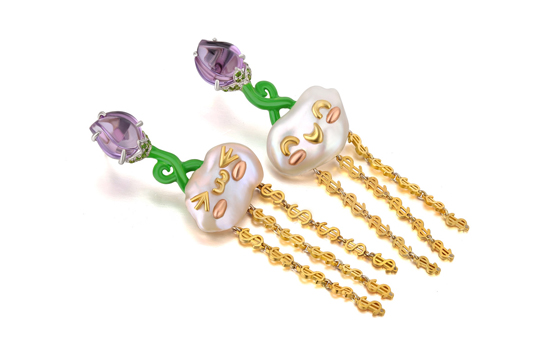
Tell us a bit about yourself.
My name is Beatrice and I am from Milan, but I have been studying BA Jewellery Design at Central Saint Martins in London for the last four years. I am very lucky to have found my passion so early in life because it truly is what I want to do in my life.
What was the inspiration for this piece?
My final collection ‘The Western Orient’, which was inspired by the increasing importance of the Asian market in today’s society, is a merge between the Orient’s heritage and the West’s strong consumer capitalist culture. The motifs embedded within the jewellery hold symbiotic connotations which function as a social critique of the globalisation in Eastern Asia.
This piece in particular is based more on the Western aspect as it focuses on the phenomenon of conspicuous consumption by means of stating the ‘price’ on the pearls.
What do you like most about pearls?
I like how timeless and elegant pearls are and the contrast that they create in my work, which uses very contemporary imagery. The pearls in my collection make my jewellery look more refined as they give it a lustrous classic undertone.
What’s your motto?
"Dream big"
CLAUDIA RICE
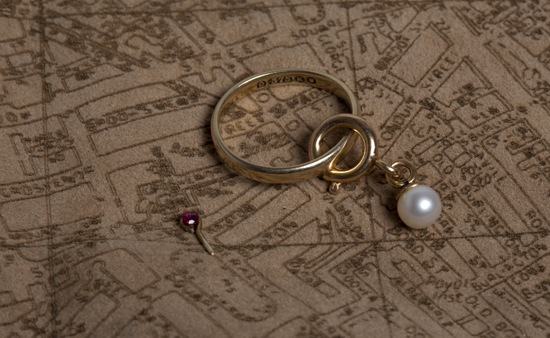
Tell us a bit about yourself.
My name is Claudia Rice and I have come into the craft of jewellery making and designing from having my father (and his father) in the jewellery business all his life as my influence. Starting as a watchmakers apprentice at 15, he was a traveling salesman for Mikimoto and Rosita Pearls during the 70s, setting up workshop in Hatton Garden to having his own shop in Marylebone high street, where I spent a lot of my time.
These surroundings have fed my desire to be part of that and continue my family trade.
What was the inspiration for this piece?
My inspiration stemmed from research into my dissertation on the subject of The History of Hatton Garden and my family connection with it. Becoming intrigued by maps of old London, discovering locations of ‘hidden treasures’, using an A-Z from 1969 and making a link with the modern technology of Google Maps.
What has been your best experience or moment at CSM?
Winning a design award from the Worshipful Company of Tin Plate workers.
What’s your motto?
“What goes around…”
EMILY WRIGHT
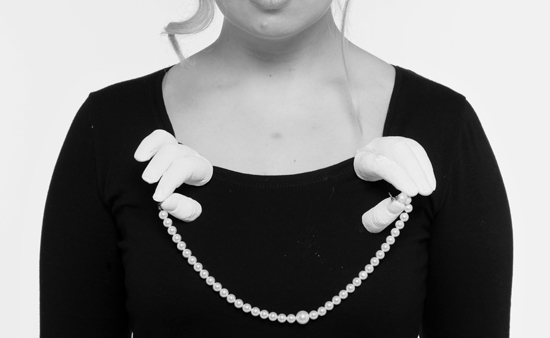
Tell us a bit about yourself.
I am a quietly confident person, I enjoy being creative and I don’t work well under pressure!
What was the inspiration for this piece?
The theme for my collection is reconnecting with those we have lost, through every day gestures, such as the simplicity of placing a necklace on a loved one.
What’s next for you?
Graduating (hopefully) and going into the world of work.
What do you like most about pearls?
I love the simplicity of pearls, they are glamorous in a beautiful yet understated way.
What has been your best experience or moment at CSM?
I have enjoyed the opportunities CSM has provided, and the opportunities we have had that we wouldn’t have gotten anywhere else.
Who is your favourite designer or artist and why?
I love the sculptures of Barbara Hepworth, I love the simplistic designs and the perfection in the lines.
What’s your motto?
"The best things in life aren’t things."
-
Bella Mung - Winterson Prize 2013
Bella Mung - Winterson Prize 2013
Congratulations to Bella Mung, the winner of the Winterson Prize 2013 for the Best Use of Pearls.
Announced yesterday evening at Central Saint Martins, London, Bella was awarded the prize for her contemporary and often humorous exploration of the use of pearls in everyday fashion.

There were many pieces of a high standard in the CSM BA Jewellery Design Class 2013, including Claudia Rice's collection of historically inspired jewellery and Simeï Iréne Snyman's ambiguous fantasy garden of ceramic food.
The judges, which included CSM course leader Caroline Broadhead and designer Alice Cicolini, however, loved the detailed development of Bella's concepts throughout the last year.
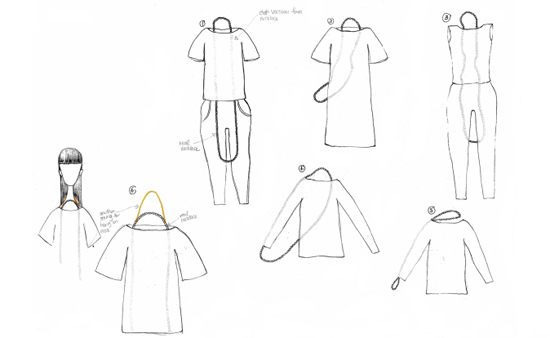
Initially exploring the idea of the hidden shape and form of a necklace beneath a garment, inspired by her mother's jewellery, Bella playfully extended the concept to using pearls in different pieces of attire.
These often amusing and sometimes peculiar pieces of fashion included a pearl necklace that transformed into a tie, a hoody with its suggestion of pearls and a pair of gentlemen's pearl-studded brogues.
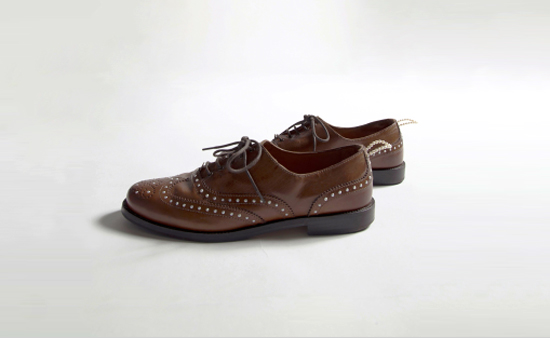
The stand-out piece was this pearl necklace (above) that was transfixed like the wearer's hair blowing in the wind. The considered shape and graduation of the necklace was perfect.
We asked Bella about her inspiration and plans for the future:
Tell us about yourself.
I studied the foundation of art and design in Los Angeles and found out I am very interested in the jewellery field.
What was the inspiration for this piece?
I love the way my mother wears her mother's silver chain half hidden by her clothes and half shown. I copy the way she does this by combining a pearl necklace with everyday wear.
What's next for you?
I will be doing an internship in BLESS after I graduate and applying for an MA degree at the Royal College of Art in 2014.
Name one jewellery toolbox essential that you can’t live without.
My Pearl knotter.
-
Five Minutes with Caroline Broadhead, CSM
Five Minutes with Caroline Broadhead, CSM
We recently announced a very special collaboration in Pearls with the BA Jewellery Design course at Central Saint Martins (CSM), the creative arts institute of the University of the Arts London.
This week sees the start of the second set of degree shows at CSM, which are a celebration of design and the final year students' work. Later this week, we will also be announcing the winner of our prize for the Best Use of Pearls amongst the final year Jewellery students.
Here, we take five minutes with Caroline Broadhead, who is the course leader at CSM, to ask for her views on jewellery and pearls.
Caroline's own work in jewellery has explored the use of textiles and developing her work into garment form. She has exhibited extensively in the UK and internationally, including recently in the Unexpected Pleasures contemporary jewellery exhibition at the Design Museum, London.
Tell us a little about yourself and your role at CSM?
I am Course Leader, which means I have responsibility for the overall direction and management of the 3 year course. I also teach across the years, though mainly I am involved with the final years, along with the Year 3 tutor, Lin Cheung.
What does ‘jewellery’ mean to you?
Jewellery can be superficial or significant; an accessory or fundamental; mean nothing or everything. The subject can be interpreted widely, as it represents what we value.
It can be a spatial, formal construction relating to the physical body; as something worn close to the body it can relate to the emotions; it can indicate our relation to materials and what we do with them; it can be the means of expressing identity and reading that of others.
What influences have inspired you in your own design, can you give us an example?
A very obvious example was when I travelled to Africa in the late 70s and saw Masai jewellery being worn, colourful, bold designs that dominate the body. I also observed the women weaving baskets in the markets and both those came together later in woven nylon work. Other than that, it is a combination of a lot of different things.
What should come first in design - material, form or function?
I think that the best designs are those where these work together. Some people start from a particular material, shape or function and take it from there, but everyone has a different process and there is no failsafe formula.
What trends in current jewellery design do you like the most and least?
I am very supportive of the growing awareness of ethics and sustainability in the jewellery world.
What do pearls mean to you?
They are beautiful and organic.
What are the opportunities today for using pearls in jewellery design?
A string of pearls is an iconic piece of jewellery and pearls, as such, are ripe for experiment and questioning to extend their potential.
What are the main challenges for a new jewellery designer starting out?
Gaining the relevant experience of how to run a business is something that takes time and it is easy to make expensive mistakes. Each person has to find out what the appropriate context is for their work and how best to promote, sustain and develop it.
What is the best advice that you give to your students?
Have faith in yourself, don’t stop working.
What is your favourite part of the working day?
The first bit, when I feel I can get through all the things on my To Do list!
-
Central Saint Martins and Pearls
Central Saint Martins and Pearls
We are delighted to announce a very special collaboration in Pearls with the BA Jewellery Design course at Central Saint Martins (CSM), London.
Central Saint Martins ranks amongst the most influential arts institutes in the world. It has the reputation for being the home of creativity. The College exists to generate knowledge, to inspire creativity and develop the next generation of ambitious designers, artists and performers. CSM attracts the world’s most talented students. Drawn from over 90 countries the students represent some of the world’s most exciting raw talents.
What will we be doing with CSM this year?
Firstly, we have been working with a selection of Year Three BA Jewellery Design students so that they have a fantastic opportunity to be given free rein to produce a stunning piece of jewellery using pearls. With our own heritage of over 50 years of knowledge and experience of working with pearls, we hope this collaboration will be a great experience for these soon-to-be graduates.
In June, Winterson will be awarding a prize for the Best Use of Pearls at the Jewellery Awards evening on 20th June 2013 during the Central Saint Martins degree shows.
Secondly, the Year One BA Jewellery Design students at CSM are working in conjunction the upcoming Pearls exhibition to be held at the Victoria and Albert Museum (V&A), the world famous museum of art and design, in the Autumn later this year. The exhibition explores the history of pearls from the early Roman Empire through to the present day, the beauty and allure of pearls which across centuries and cultures have long been associated with wealth, royalty and glamour.
Following an introductory talk by the exhibition's curator Beatriz Chadour, the students will be investigating the historic and cultural significance of pearls and their contemporary relevance and versatility. In addition they will be given a handling session at the V&A and experimenting directly with pearls in the workshops.
We will also be supporting these students with a range of pearls to work with. The results will be shown at the V&A on the Pearls exhibition Study Day, alongside a How to Wear Pearls event, which the students will be hosting.
It's a truly great privilege to be working with these two highly respected institutions of design.
Follow our Journal or Facebook page to keep up to date with how the collaboration develops this year.
-
Spring Rocks into Fashion at LFW
Spring Rocks into Fashion at LFW
If you happened to wander past Somerset House in London last weekend, you may have caught a sense of the semi-annual excitement that is London Fashion Week (LFW).
For the last 5 days, some of the UK's outstanding designers have been unveiling their carefully assembled new season's fashions and accessories for Autumn Winter 2013.
LFW this year hosts The Rock Vault again with fine jewellery being exhibited in the West Wing of Somerset House. The group of 10 talented jewellers included Fernando Jorge, Hannah Martin, Husam El Odeh, Imogen Betfield, Jo Hayes Ward, Melanie Georgacopoulos, Sophie Bille Brahe, Tomasz Donocik, Yunus & Eliza, and for the first time, Alice Cicolini.
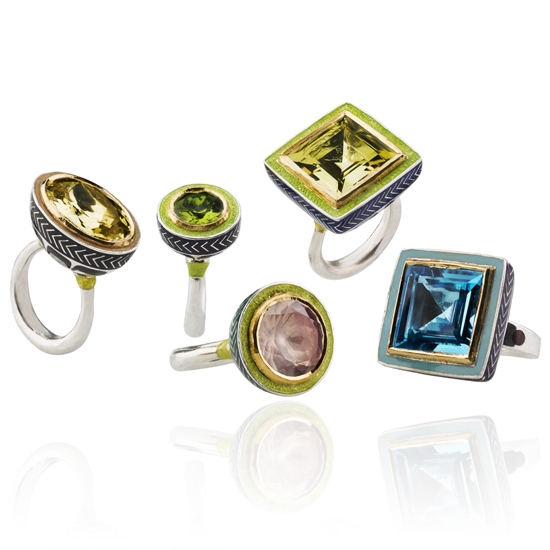
Alice Cicolini is a London based jeweller who studied at the London College of Fashion and received her MA in Jewellery Design from Central Saint Martins. Her jewellery designs are characterised by richly coloured gems and covered with the deep, jewelled tones of vitreous enamel.
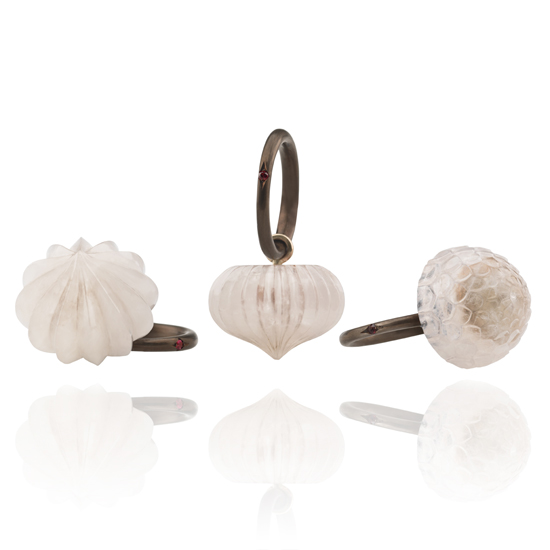
Alice explains “Coming from a curatorial background, my work blends influences from many sources - for example, Bauhaus costume, mid-century British ceramics, traditional South Asian and Far East Asian textiles, and of course the possibilities opened up by the craftsmanship.”
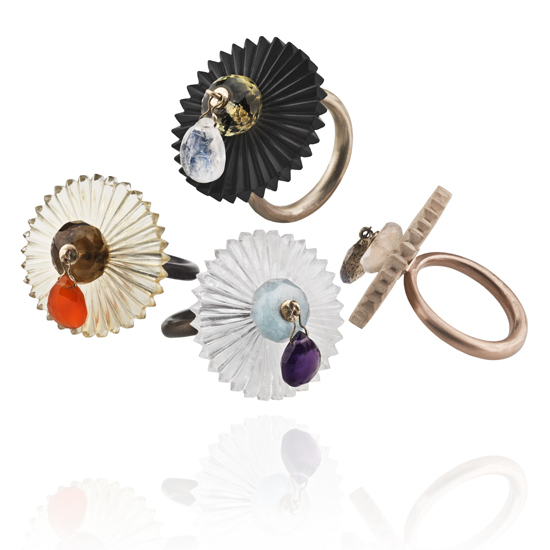
At Winterson we have been collaborating with Alice Cicolini to develop a collection of pearl rings and look forward to launching her new jewellery collection in the Spring later this year.
Elsewhere around the main show tent in the square and its side rooms, the atmosphere positively bustles with the ultra fashionable, the eccentric and often a particularly British sense of humour. Photographers gather at the entrance to snap at the crowd as the famous and fashionistas pause for the camera.
Most eye-catching perhaps are the shoes, with extreme heels and platforms being guided dangerously and skilfully across the paved square. In this world of fashion, you won’t fail to smile or be inspired by the use of colour and design.
-
What's Knot to Love about the Bow
What's Knot to Love about the Bow
Study any book on the history of fashion or jewellery and there is likely to be a bow design featured in its pages. This legendary motif is a symbol of love or marriage, and like the knot and the tassel, its origins are inspired by the most simple of fastenings.
From the late 17th century in the French royal court of Louis XIV, the bow motif in jewellery was perhaps first popularized. At a time when trade in gemstones was growing, and with new stone cutting techniques being developed, women enjoyed wearing sparkling bow jewels pinned or stitched to their attire.
How bow jewellery was worn also carried its own meaning – a bow attached to a ribbon adorning a woman's neck is said to have suggested a playful side, whilst a bow-shaped brooch worn close to the heart was a sign of being in love.
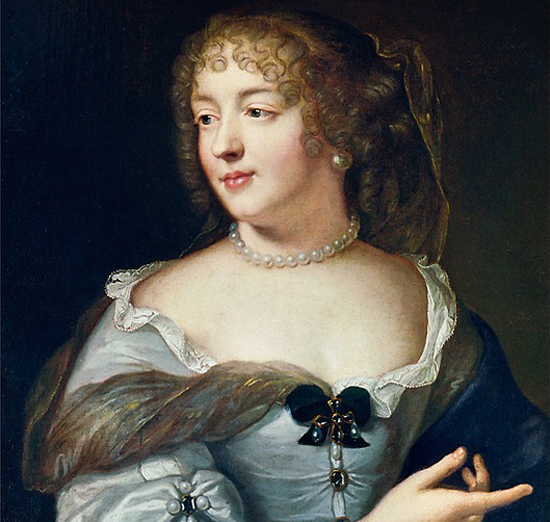
Bow brooches were known as Sévigné, named after the Marquise Marie de Sévigné, a French aristocrat who wrote numerous letters to her daughter depicting life at the 17th century Court.
An early description of the Sévigné brooch was by H. Clifford Smith in the early 20th century who wrote that "an important jewel worn at this time was a breast ornament, termed a Sévigné, after the celebrated lady of that name. This ornament took the form of a bow or rosette of open-work, of foliated design, generally of silver, set with small diamond splinters." (Source: Jewellery. G. P. Putnam’s Sons. New York. 1908).
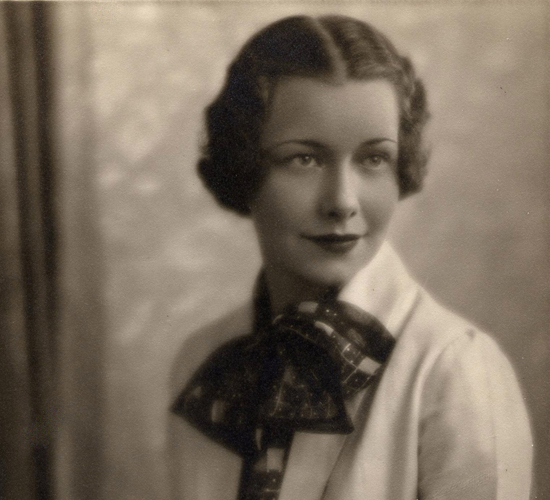
The bow motif fell out of fashion with the French Revolution, but by the early 1900s appeared again as a favoured design motif of Edwardian ladies. Necklaces, earrings, pendants, rings and brooches in the shape of bows are very characteristic of the period.
With advances in the techniques to make platinum, bow jewellery designs also became delicate and elaborate like embroidery, and were often decorated with diamonds.

The bow is as popular today with its shape, symbolism, and classic influences in fashion. At Winterson, we are working on a new designer collection with Alice Cicolini that is inspired by the history of this celebrated motif.
-
Alice Cicolini To Design New Collection
Alice Cicolini To Design New Collection
We are thrilled to be announcing a new design collaboration with Alice Cicolini, a London-based jewellery designer, curator and author.
We have been working with Alice throughout this year to develop our new collection of pearl rings, which has just launched at Winterson. The collection features classic Akoya, South Sea and Tahitian pearl rings with diamonds and colourful gemstones, set in 18 carat gold.
Alice is best known for her beautiful and unique jewellery, which is inspired by the enamel traditions of Persia and the patterns and traditions of the Silk Route. Her pieces are handmade in India to the highest quality of craftsmanship, using an artisanal technique of placing enamel onto metal called meenakari.
This traditional enamelling style originated in the courts of Persia and was established in the early 1600s in Jaipur, Rajasthan. Colourful layers of enamel are laid into grooves in the metal and fired individually to build up a complex and intricate pattern that can turn a piece of jewellery into a work of art. Often this detail might only be visible to the wearer.
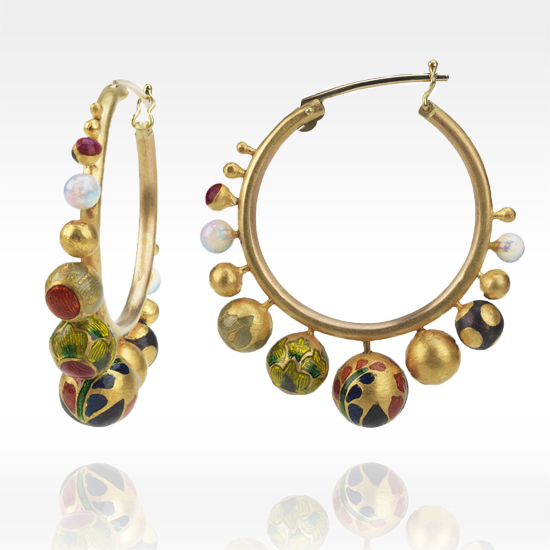
Alice's Silk Route, Jodhpur and Silver Tile jewellery collections combine vivid reds, yellows, pinks, blues and greens and are quite wonderful to see. The new hoop earrings (pictured above) from a new collection called Orbital feature enamelled 22ct gold and shimmering white opals.
A background as a former Director Arts & Culture for the British Council in India, a graduate of Central Saint Martins in London and an author on contemporary British dandyism, give some clues to Alice's love for fashion and creative design. She has exhibited at Somerset House and Sotheby's in London, as well as curating a number of international exhibitions on design.
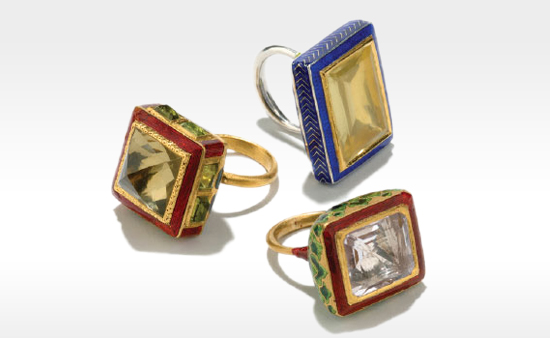
Enamelling was also a favourite technique of the Art Nouveau jewellers such as Lalique and Fabergé around 1900. Around this same time seed pearls were very popular, being used to decorate brooches, bows and earrings.
What might be possible today?
Inspired by the tradition and combination of these classic materials, the new Alice Cicolini collection for Winterson will be launched in Autumn 2013.
-
Interview with Designer Sophie Breitmeyer
Interview with Designer Sophie Breitmeyer
Launching three new ranges of jewellery this Autumn is Sophie Breitmeyer, an award-winning designer that we were delighted to be able to collaborate with last year. It has been a busy year for Sophie, with a move to a studio at the Goldsmiths Centre, her bespoke jewellery business, and being nominated for Retail Jeweller's Catwalk Jeweller of the Year 2012 for her collaboration with design house Fyodor Golan.
Sophie tells us about her new collections for next Spring/Summer 2013.
What was the inspiration for the new Serpentina range?
The collection was inspired by The Rainbow Portrait, a historic painting of Elizabeth I, in which Elizabeth's dress is heavily embellished with pearls and a serpent knotted around her arm. This English Heritage inspired collection combines snake like twists with classic freshwater pearls to show two different angles of the jewellery. With a selection of earrings, necklaces and entwined rings, the collection is traditional with an empowered modern style.
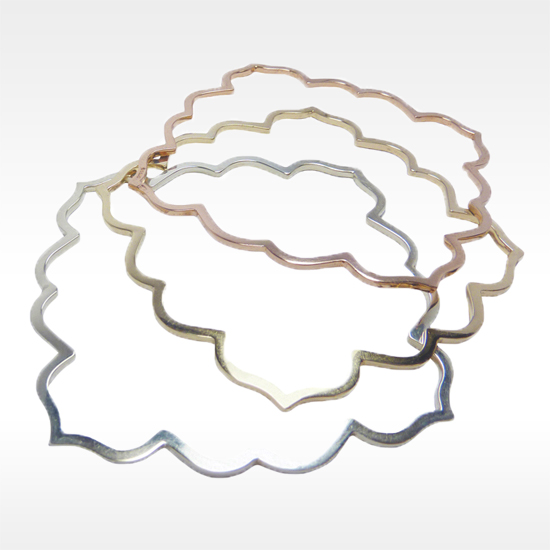
What makes a piece of jewellery unique?
Whilst designing, I try to accomplish three things in the jewellery: to make it classic, unique and desirable. I believe that these three things are essential to women when buying jewellery for longevity. Unique to me means being original and different, for example manipulating the shape of fabric into an intricately handmade piece of metal, as with my Miniature Ruffle collection.

What style direction is jewellery moving in at the moment?
There are so many trends with jewellery at the moment, with one being the use of alternate materials such as palladium and colourful semi-precious stones to make fine jewellery more affordable. I try to design with classic looks in mind, to make a piece that will be timeless and will always stay in fashion. Of course these need to be desirable....what girl isn't happy when her friends want her clothes and jewellery?
What are you looking forward to in 2013?
I have a lot of exciting plans for next year, including new collections and making these available through my new website and other stockists.
-
Enchanting Styles of Pearl Drop Earrings
Enchanting Styles of Pearl Drop Earrings
With their shining, lustrous surface and pretty shapes, pearls have inspired ancient myths of gods, angels and mermaids and been revered as fallen teardrops. Loved today by women, royalty, brides and fashion icons, the beautiful styling of pearl drop earrings may echo these enchanting images.
THE PEARL
As the central element, pearls are a foremost consideration in any design of pearl drop earrings. Round, near-round, oval or drop shaped pearls are favoured by designers as their symmetrical shapes allow the jewellery to be admired from every angle. We would recommend selecting exceptional pearls with a high lustre and clean surface, as well as larger sizes of between 8 and 12 millimetres in diameter.
All types of pearls are suitable for pearl drop earrings and the design choice depends on the direction of the styling and budget. Freshwater pearls can be beautiful and offer excellent value, Akoya pearls are perfect for their high lustre and pink overtones, Tahitian pearls for their contemporary, cooler hues and South Sea pearls for their luxurious silvery white and golden colours. Whichever the pearl type, both the pearls used in pearl drops should be matched carefully for comparable grading.
THE DESIGN
The classic design of a pearl drop earring is that of a pearl attached to a stud or a hook, composed of silver or gold. The pearl may sit just below the stud or hook, or may hang below between two to four centimetres in length. Longer pearl drops today are fashionable, easy to wear and very popular.
The attachment of the pearl to the drop may be rigid or supple with a chain that creates a pleasing movement in the form of the jewellery. Designs may also include multiple pearls on each earring, amplifying the elegance of the movement.
Amongst our contemporary designs, Sophie Breitmeyer has created a collection of Akoya pearl drop earrings with sparkling and colourful gems of blue sapphires, green tsavorite garnets and pink rubies.
THE OCCASION
Pearl drop earrings are very versatile, suiting women of all complexions and hair styling. Completed with sparkling diamonds or gemstones, pearl drop earrings are a perfect choice of fine jewellery for smart evening wear.
-
Jewellery at London Fashion Week 2012
Jewellery at London Fashion Week 2012
London Fashion Week 2012 (LFW) just closed its doors after five days of exciting and creative activity, with new fashion collections being presented to buyers for the Spring / Summer 2013 season. For the second time, the Rock Vault at LFW also showcased some of Britain’s most innovative, fine jewellery talent. This week, it was located in the West Wing of Somerset House, at the heart of London Fashion Week, between the 14th to the 18th of September.
Exclusively for the event, a dozen leading jewellers were invited to design a unique ring using the precious metal palladium with the support of the International Palladium Board. The selected designers were Alexandra Jefford, Fernando Jorge, Hannah Martin, Hillier, Husam El Odeh, Imogen Belfield, Jo Hayes Ward, Jordan Askill, Melanie Georgacopoulos, Sophie Bille Brahe, Tomasz Donocik and Yunus & Eliza. The palladium rings were displayed in the entrance of the Rock Vault to welcome, and even entice, some of the 5,000 visitors of London Fashion Week into the vault.
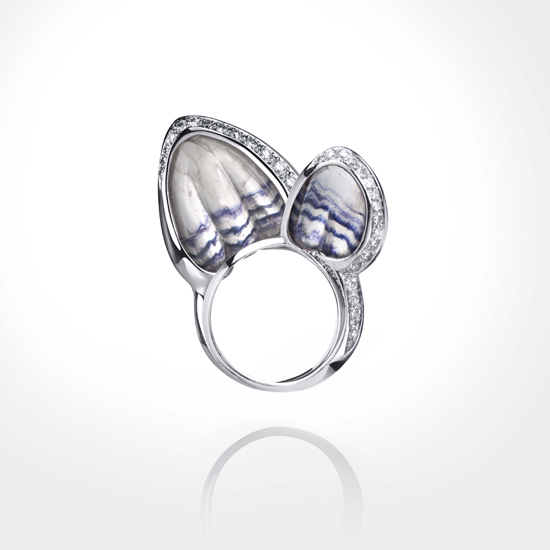
Our personal favourite was Fernando Jorge's beautiful butterfly inspired ring and earrings, displaying a traditional British mineral gemstone called Blue John.
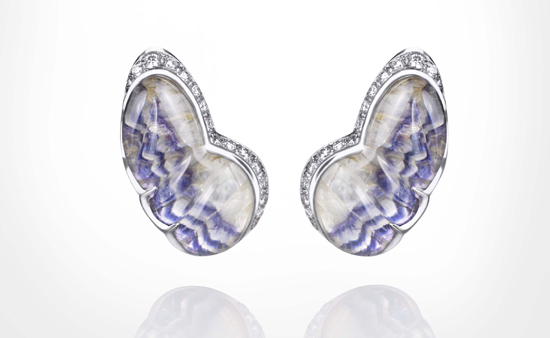
Amongst the main collections, Fernando Jorge also exhibited his new 2012 collection Green Series as well as some of his latest designs. Brazilian-born Fernando uses gemstones and craftsmanship native to Brazil and the Green Series sees his signature style evolving with its fluid lines and elegantly cut gems. His pieces are available in limited editions as each gemstone is unique and the collection effortlessly conveys a sense of beauty, sensuality and opulence.
On the catwalk this year at LFW, the main fashion brands brands introduced their new SS 2013 collections with jewellery that ranged from the bold and colourful, to the more classic. Vivienne Westwood complemented her trademark edgy British fashion style with pearl necklaces on the catwalk, worn in single, double and elaborate multiple strands, sometimes with the hint of an occasional pearl drop earring.